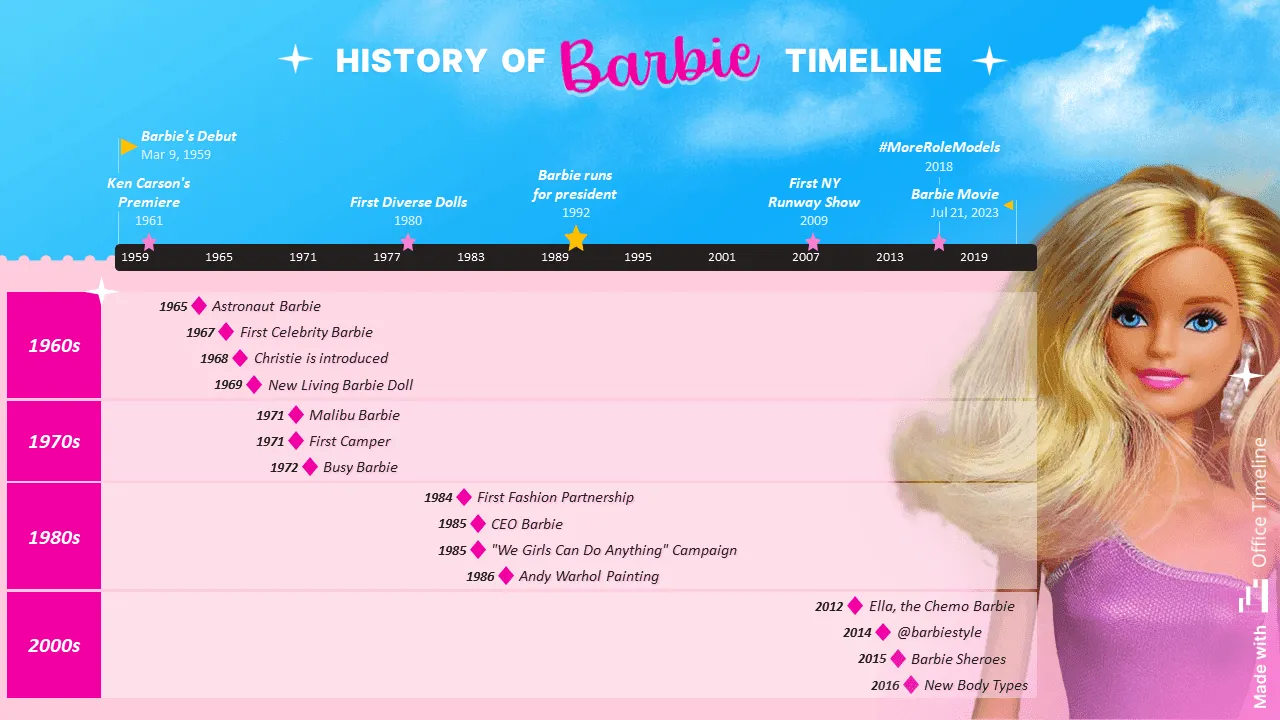History of Barbie timeline
Explore the iconic journey of Barbie through the ages! From her debut in 1959 to her recent cinematic success, delve into the history of this timeless cultural icon. Celebrate Barbie's enduring impact on generations worldwide with our captivating timeline
As “Barbie” – the highest grossing film worldwide in 2023 – is undoubtable a popular and critical success, we can’t help but be amazed at the relevance that the American doll designed in the late 1950s still has to this day.
Captivating the hearts and imagination of generations worldwide, Barbie has reigned supreme for more than six decades in the industry of fashion dolls and toys. To celebrate her impact as a symbol of empowerment and diversity, we have created the history of Barbie timeline, which overviews her evolution since her debut in 1959 to her recent cinematic adventure and status as a timeless cultural icon.
History of Barbie timeline: shortlist of key events
- 9 March, 1959 – Barbie’s Debut
- 1961 – Ken Carson’s Premiere
- 1965 – Astronaut Barbie
- 1967 – First celebrity Barbie
- 1968 – Christie is introduced
- 1969 – New Living Barbie Doll
- 1971 – Malibu Barbie
- 1971 – First Camper
- 1972 – Busy Barbie
- 1980 – First diverse dolls
- 1984 – First fashion partnership
- 1985 – CEO Barbie
- 1985 – “We Girls Can Do Anything” Campaign
- 1986 – Andy Warhol Painting
- 1992 – Barbie runs for president
- 2009 – First NY Runway Show
- 2012 – Ella, the first Chemo Barbie
- 2014 – @barbiestyle
- 2015 – Barbie Sheroes
- 2016 – New body types
- 2018 – #MoreRoleModels
- 21 July, 2023 – “Barbie” movie
History of Barbie: a timeline of events
Let’s have a more in-depth look at the key milestones in the evolution of Barbie and her entourage.
9 March, 1959 – Barbie’s Debut
This day marks the birth of the first fashion doll called Barbie (full name being Barbara Millicent Roberts). Created by businesswoman Ruth Handler, Barbie mimicked the glamour of 1950s stars such as Elizabeth Taylor and Marilyn Monroe. Manufactured and introduced to the world by American toy company Mattel, the first Barbie dolls sold for $3.
Launched at the New York Toy Fair, the prototype Barbie wore a black and white striped swimsuit and her signature ponytail. Although buyers were skeptical about her success because she was unlike the other baby and toddler toys popular at the time, Barbie took the world by storm and inspired little girls to imagine their futures like never before.
1965 – Astronaut Barbie
Four years before man landed on the moon, Barbie went galactic. Wearing a cool space suit and helmet, Miss Astronaut Barbie celebrated the excitement of exploring new frontiers and encouraged girls to reach for the stars.
1967 – First celebrity Barbie
Based on the British fashion model Twiggy, the original celebrity Barbie doll had iconic Twiggy makeup and wore a yellow, green, and blue vertical-striped mini dress, and yellow boots. Cher, Audrey Hepburn, Diana Ross, and JK Rowling are a few of the many other famous persons to later join the ranks of celebrity Barbies.
1968 – Christie is introduced
In support of Equal Rights and to represent the cultural diversity of the time, Mattel launched Christie, the first African American doll in the Barbie collection. Presented as one of Barbie’s good friends, Christie would pave the way to the introduction of the first official African American Barbie in 1980, alongside a Latina Barbie and the first of more than 40 different international Barbies released to date.
1969 – New Living Barbie Doll
The year 1969 saw the arrival of Barbie’s version with bendable ankles, knees, elbows, and waist.
1971 – Malibu Barbie and First Camper
Ready to go on adventures, Malibu Barbie came along in a groovy camper equipped with a picnic setup, pop-out tent, and sleeping bags. Sparking little girls’ imagination with the charm of exploring the great outdoors, Malibu Barbie was an instant hit, running through 1977 and making recurrent appearances.
1972 – Busy Barbie
Getting thumbs, Busy Barbie can grasp everything that comes her way, including numerous hip accessories such as a princess telephone, travel case, record player, and many more.
1980 – First diverse dolls named Barbie
Although many diverse dolls were available over the years, they were always friends of Barbie. This time, Mattel releases the first African American and Hispanic dolls named Barbie.
1984 – First fashion partnership
Currently listed as the brand that has worked with the most fashion designers in the world, Barbie made its first fashion collaboration with Oscar de la Renta. The famous couturier’s line of designer clothes created for the iconic doll included glamorous jewel and metallic outfits that brought creativity-fueling runaway fun to young fashion lovers.
1985 – CEO Barbie
Celebrating the workplace evolution of the era, Day-to-Night Barbie broke the glass ceiling as a CEO. Being able to run the boardroom in her pink power suit and also to have a fun night out on the town, CEO Barbie showed girls they could have it all.
1985 – “We Girls Can Do Anything” Campaign
Featuring a theme song that had girls singing “We girls can do anything, right Barbie?” and “Anything is possible as long as I try”, this series of commercials encouraged girls to believe in themselves and their dreams.
1986 – Andy Warhol Painting
Given his well-known fascination with American icons such as Jackie Kennedy, Marilyn Monroe, and Elvis Presley, it came as little surprise that the Pop artist would add Barbie on the list of iconic figures to depict. The inspiration for the first Barbie portrait reportedly came from Warhol’s longtime friendship with Billy Boy, a jewelry designer and avid Barbie collector. To return the favor, Mattel issued an Andy Warhol-themed Barbie collectible in 2016.
1992 – Barbie runs for president
For her first election year, President Barbie received an American-themed dress to wear at the inaugural ball and a red suit for her Oval Office duties. Having hit the campaign trail ever since and releasing an all-female ticket with a president and vice president doll set in 2016, Barbie has inspired girls to believe they can be anything, including leader of the free world.
2009 – First NY Runway Show
To celebrate her 50th anniversary, Barbie held her first runway show in the New York Mercedes-Benz Fashion Week. Original creations by 50 notable designers were featured with the occasion.
2012 – Ella, the first Chemo Barbie
To show support for young girls with cancer, Mattel produced a bald friend of Barbie called Ella. Initially created only in a limited number to be distributed directly to hospitals in 2012, Ella was reissued in 2014 as response to a petition from a cancer patient’s mother.
2014 – @barbiestyle
Barbie proved her versatility once again, taking the role of social media influencer with the launch of the @barbiestyle Instagram account. Created to celebrate pop culture moments as seen through an icon’s eyes, @barbiestyle quickly became a leading fashion influencer channel that excites followers on topics ranging from art and fashion to culture and travel.
2015 – Barbie Sheroes
To celebrate inspiring female heroes who break boundaries and expand the possibilities for women everywhere, Barbie introduced one-of-a-kind dolls for each of the Shero honorees among which are included Ava DuVernay, Emmy Rossum, Eva Chen, Kristin Chenoweth, Sydney “Mayhem” Keiser, and Trisha Yearwood.
2016 – Barbie introduces new body types
By introducing curvy, petite, and tall as the three new doll body types to better reflect the world that girls see today, Barbie landed on the cover of Time magazine.
2018 – #MoreRoleModels
In an effort to inspire more girls by shining a light on empowering role models, Barbie launched the #MoreRoleModels campaign on International Women’s Day. The Inspiring Women doll line was also released to honor extraordinary women from all over the world, featuring figures like Frida Kahlo, Amelia Earhart, and Katherine Johnson.
21 July, 2023 – the Barbie movie is released
Giving a modern twist to Barbie’s image, the Greta Gerwig-directed movie reenforces the iconic doll’s legacy in today’s times by showing how Barbie surpasses the existential crisis that brings her entire world into question. Since its release, “Barbie” – the movie has become a global phenomenon and 2023’s highest-grossing film, surpassing “Oppenheimer“, another strong contender for box office hit title.
FAQs about Barbie
Here are the short answers to the most frequently asked questions about America’s most famous doll.
The brainchild of Ruth Handler, Barbie was created to expand the toy choices for little girls in the 1950s. Watching her two children play, she realized that her daughter could only act as a mom or caregiver, whereas her son had toys that allowed him to imagine himself as a firefighter, doctor, astronaut, and more. It was then that the Mattel co-creator decided to offer her daughter the possibility of playing with as many action figures as her brother had.
Barbie was created by Ruth Handler, a mother, entrepreneur, co-founder, and former president of the toy company Mattel. Handler’s inspiration for Barbie came in the late 1950s from watching her daughter project her dreams and aspirations onto paper dolls. Given that back then the toys for girls were designed as babies only, Handler saw there was an unfilled niche in the market for a toy that allowed little girls to imagine the future.
The first Barbie doll was launched on 9th of March 1959 at the New York Toy Fair, wore a black and white striped swimming suit and sported her hair in a ponytail that would become a trademark.
The Barbie doll was named after Ruth Handler’s daughter, Barbara.
Here are some of the most precious and fun facts about Barbie dolls:
• Barbie’s look was inspired by a German gag gift.
• Barbie’s full name is Barbara Millicent Roberts.
• Barbie was co-designed by a missile engineer.
• Barbie brought Mattel legal troubles from the very beginning because of the resemblances to the R-rated German doll that inspired it.
About the Barbie history timeline
The History of Barbie timeline was created using Office Timeline, a professional yet user-friendly add-in designed to help you build appealing visual chronologies in PowerPoint with just a few clicks. You can download this Barbie timeline as a PowerPoint file for free and update it with any extra information using the tool’s 14-day free trial.
Project management tips and tricks
Tagged With:
TimelineTurn project data into professional timelines
Get the advanced features of Office Timeline free for 14 days.



